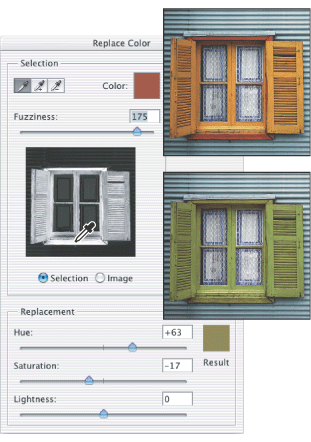Using the Replace Color command (Photoshop)
The Replace Color command lets you create a mask to select specific colors in an image and then replace those colors. You can set the hue, saturation, and lightness of the selected areas. Or, you can use the Color Picker to select the replacement color. The mask created by the Replace Color command is temporary.

Making a selection and then transforming the color of the selection
To use the Replace Color command:
- Choose Image > Adjustments > Replace Color.
- Select a display option:
- Selection to display the mask in the preview box. Masked areas are black, and unmasked areas are white. Partially masked areas (areas covered with a semitransparent mask) appear as varying levels of gray according to their opacity. For more information, see Using channel calculations to blend layers and channels (Photoshop).
- Image to display the image in the preview box. This option is useful when you are working with a magnified image or have limited screen space.
- To select the areas exposed by the mask, do one of the following:
- Use the Eyedropper tool
 to click in the image or in the preview box to select the areas exposed by the mask. Shift-click or use the Add to Sample Eyedropper tool
to click in the image or in the preview box to select the areas exposed by the mask. Shift-click or use the Add to Sample Eyedropper tool  to add areas; Alt-click (Windows), Option-click (Mac OS), or use the Subtract from Sample Eyedropper tool
to add areas; Alt-click (Windows), Option-click (Mac OS), or use the Subtract from Sample Eyedropper tool  to remove areas.
to remove areas. - Double-click the Selection swatch. Use the Color Picker to target a color to be replaced. As you select a color in the Color Picker, the mask in the preview box updates.
- Adjust the tolerance of the mask by dragging the Fuzziness slider or entering a value. This controls the degree to which related colors are included in the selection.
- To change the color of the selected areas, do one of the following:
- Drag the Hue, Saturation, and Lightness sliders (or enter values in the text boxes).
- Double-click the Result swatch and use the Color Picker to select the replacement color.
You can also save the settings you make in the Replace Color dialog box for reuse on other images. For more information on saving and loading settings, see Saving and reapplying settings.